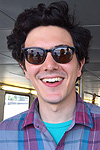Sam McDermott wins URA Thesis Award for studies on novel dark matter searches
 |
|
Sam McDermott
|
Just as there is more than one way to crack a nut, there is more than one way to search for dark matter. Some involve a telescope pointed toward the galaxies, others require detectors buried in the earth, and still others use accelerators to try to create dark matter particles.
Scientist Sam McDermott has proposed new and interesting ways to test the more novel dark matter models. This work is the focus of his Ph.D. thesis, and the Universities Research Association has recognized it with this year's URA Thesis Award, which is presented annually for outstanding work conducted at or in collaboration with Fermilab.
"The committee was impressed by the large number of studies related to dark matter in the thesis, in addition to other studies," said URA Thesis Award Committee Chair Leonard Spiegel of Fermilab. "Dark matter is an important focus of the Fermilab research program, spanning all three frontiers, and his thesis brings together many ideas for probing its nature."
Dark matter is five times more abundant than the normal matter that we're familiar with. Scientists don't know what it is, but its effects are evident in the velocity of galaxies and the way light bends around them.
According to the most widely accepted model, two interacting dark matter particles will annihilate. Scientists therefore typically try to smoke out dark matter using purpose-built telescopes that search for byproducts from the collision of two dark matter particles.
But some newer models describe dark matter differently. For example, perhaps it doesn't annihilate with itself. In that case, this asymmetric dark matter would accumulate rather than annihilate.
In one proposed approach to searching for the phenomenon, McDermott details how scientists might learn from neutron stars, among the densest regions of the universe. After building up over time, asymmetric dark matter would form a black hole inside the star, destroying it. The fact that old neutron stars (easily identified as pulsars) exist places relatively strong bounds on the asymmetric dark matter model, helpfully narrowing the ranges of properties dark matter would exhibit.
In addition to setting forth a variety of novel dark matter approaches such as this one, McDermott devoted part of his thesis to Higgs physics.
McDermott completed his Ph.D. at the University of Michigan under Kathryn Zurek. During his last year he worked at Fermilab under scientist Dan Hooper on a predoctoral fellowship. He is currently a postdoc at Stony Brook University.
"I'm very happy and honored to be given the award, and I'm excited to come back to Fermilab where I'll collaborate further with colleagues," said McDermott, who will accept his award during the Users Meeting, which takes place June 10-11.
"Universities Research Association is honored to confer this award on Sam McDermott," said URA Executive Director Marta Cehelsky. "The URA Thesis Award reflects his achievement and recognizes the vital role that Fermilab plays in the education and training of the next generation of researchers."
—Leah Hesla
|